In this scenario, learners use a bent meter stick to launch a metal puck across the classroom floor.
Table of Contents
- Supplies
- Why Teach This
- Experimental Set-up
- One Version of a Correct Energy Story
- Sample Snapshots Energy Diagrams
- Instructor Notes
- Further Discussion
Supplies
- Meter stick
- Clamp
- Puck (or similar object)
Why Teach This?
Energy Acts – This scenario provides an excellent context for students to discuss and negotiate the process of dividing a scenario into energy acts.
Friction and Thermal Energy – This scenario allows students an opportunity to explore the energy story associated with friction. They can consider whether friction plays a role even when an object is speeding up.
Experimentation – Students can design experiments to explore the details of the energy story by carefully measuring the distance the puck travels under various experimental configurations. For example student might add a lightweight paper cap to the puck to test the significance of air resistance in the energy story.
Experimental Set-up
To set up this scenario, begin by clamping a meter stick (or a 2m stick) to the leg of a table so that the stick extends parallel to the floor and is about 1cm above the floor.
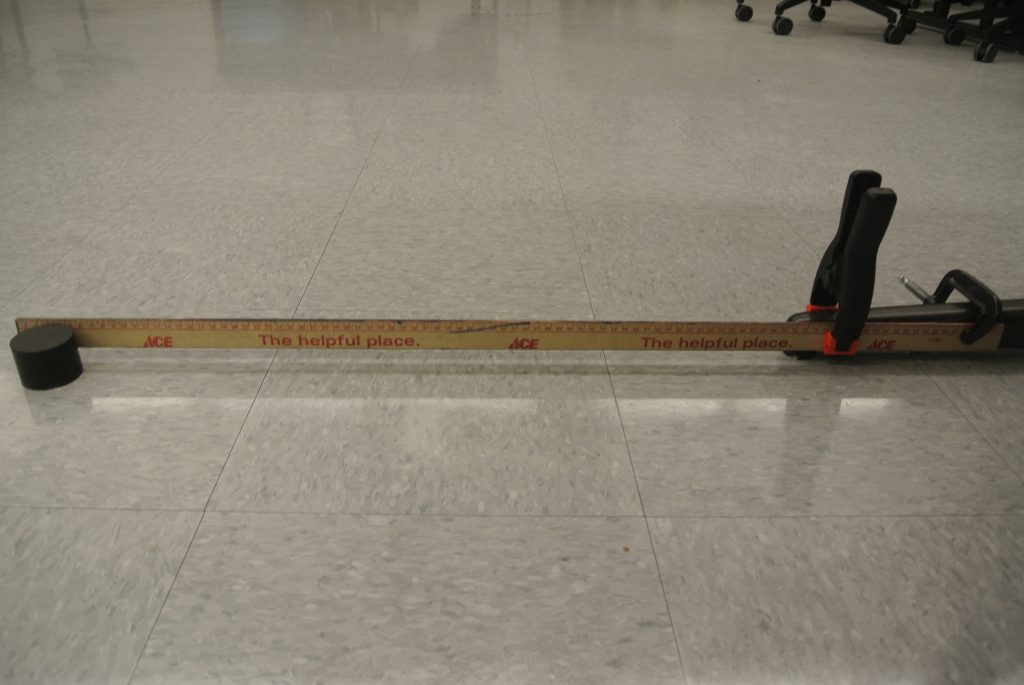
Next, place a small puck or disk in front of the free end of the meter stick and pull back the puck and the meter stick together.
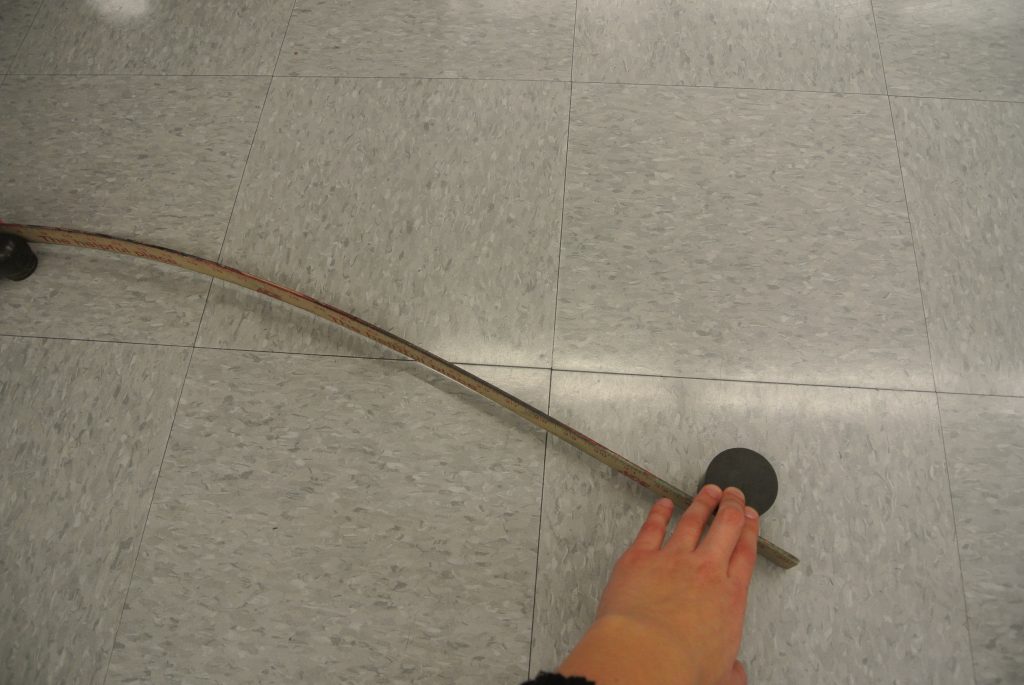
Quickly release the puck and the meter stick will launch it across the floor. You may want to practice the release a few times so that you can get a clean release.
One Version of a Correct Energy Story
Possible Energy Acts
We have found it useful to collaboratively negotiate the distinct energy acts in the puck slider scenario. Students can be encouraged to recognize that the energy processes associated with the pull back act, the launch act, and the glide act are quite different. The glide act provides a simple first scenario for students who are being introduced to a dynamic energy representation.
- Pullback
- Launch
- Glide
Pullback Act – This act begins when the person starts pulling back the puck and stick and ends when the puck is pulled back to a maximum point.
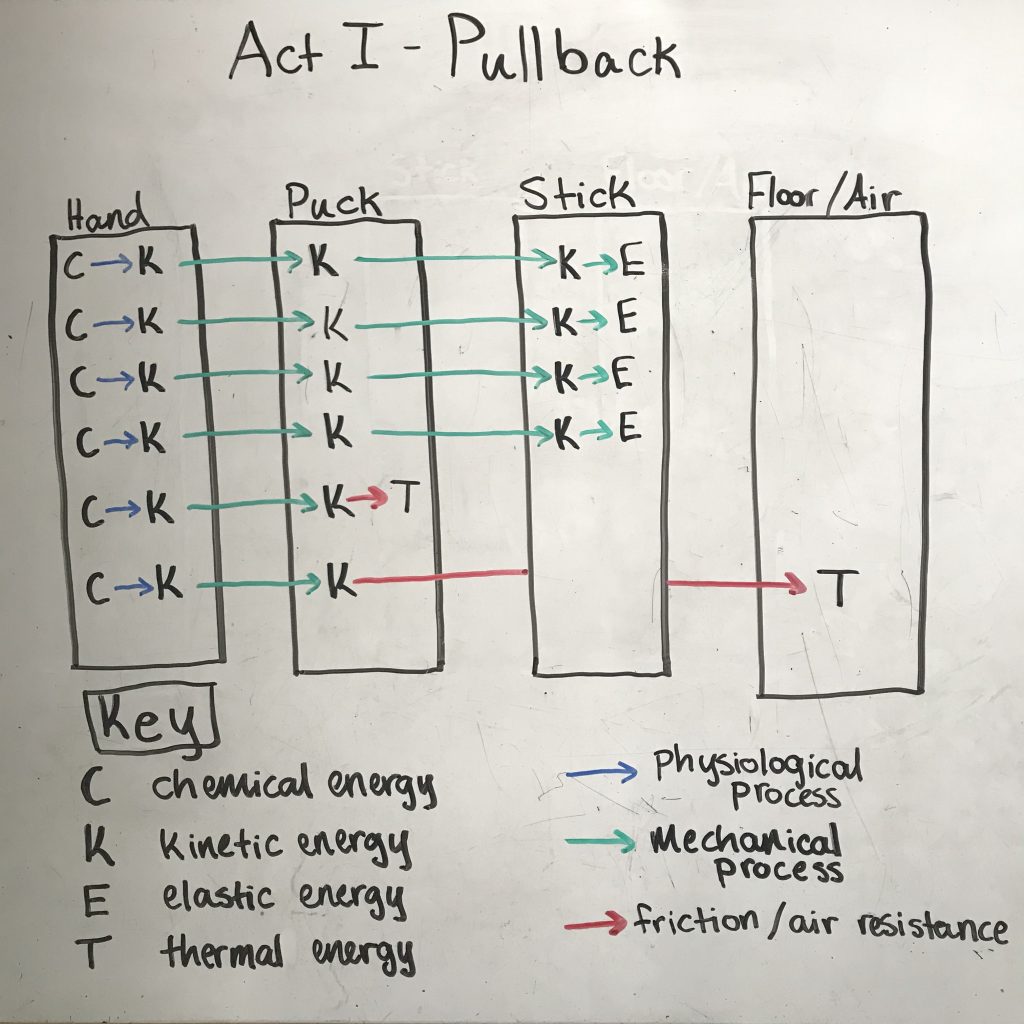
During this act chemical energy in the person’s hand/arm transforms into kinetic energy and then transfers to the stick where it transforms into elastic energy. There is also some kinetic energy that transforms into thermal energy as a result of friction.
Launch Act – Begins when the stick is released and ends when the puck separates from the stick.
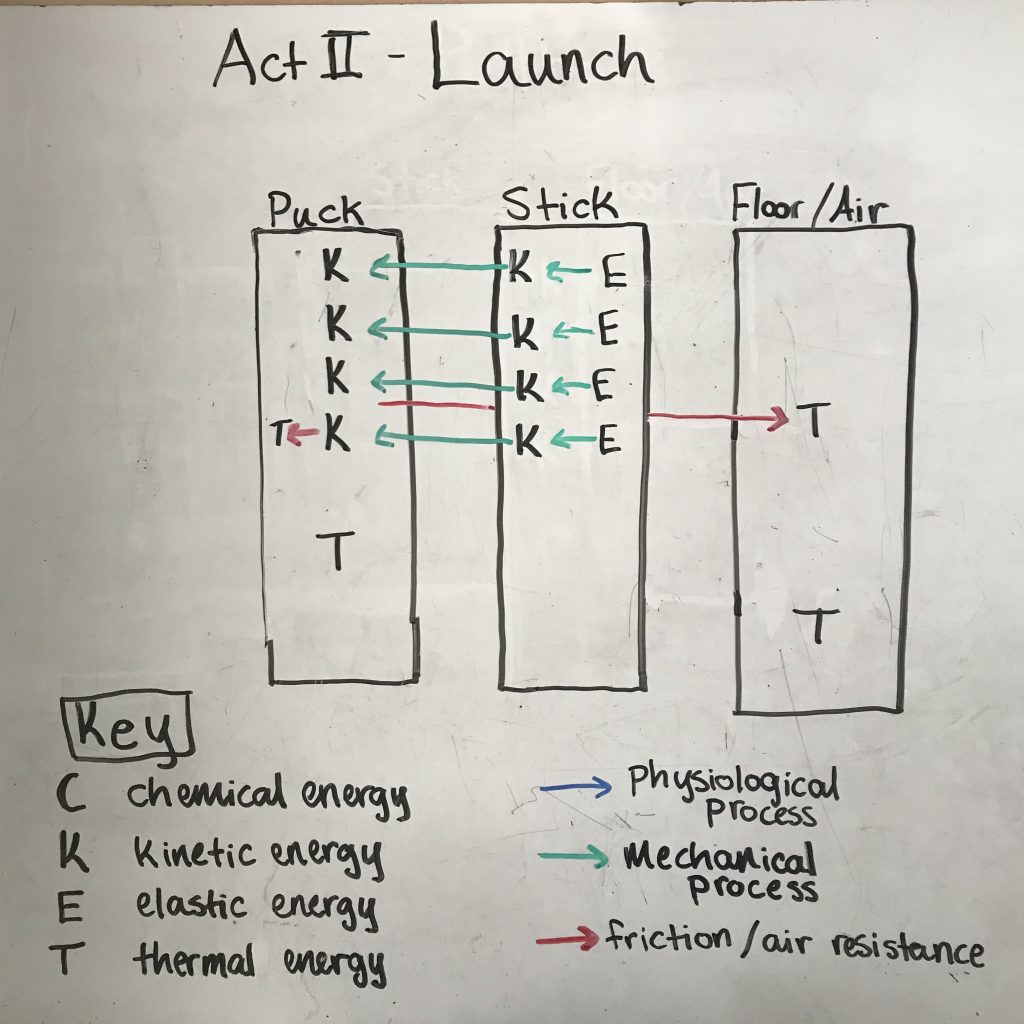
During this act elastic energy in the stick transforms into kinetic energy and transfers to the puck as kinetic energy. There is also some kinetic energy that transforms into thermal energy as a result of friction.
Glide Act – Begins when the puck separates from the stick and ends when the puck stops sliding.
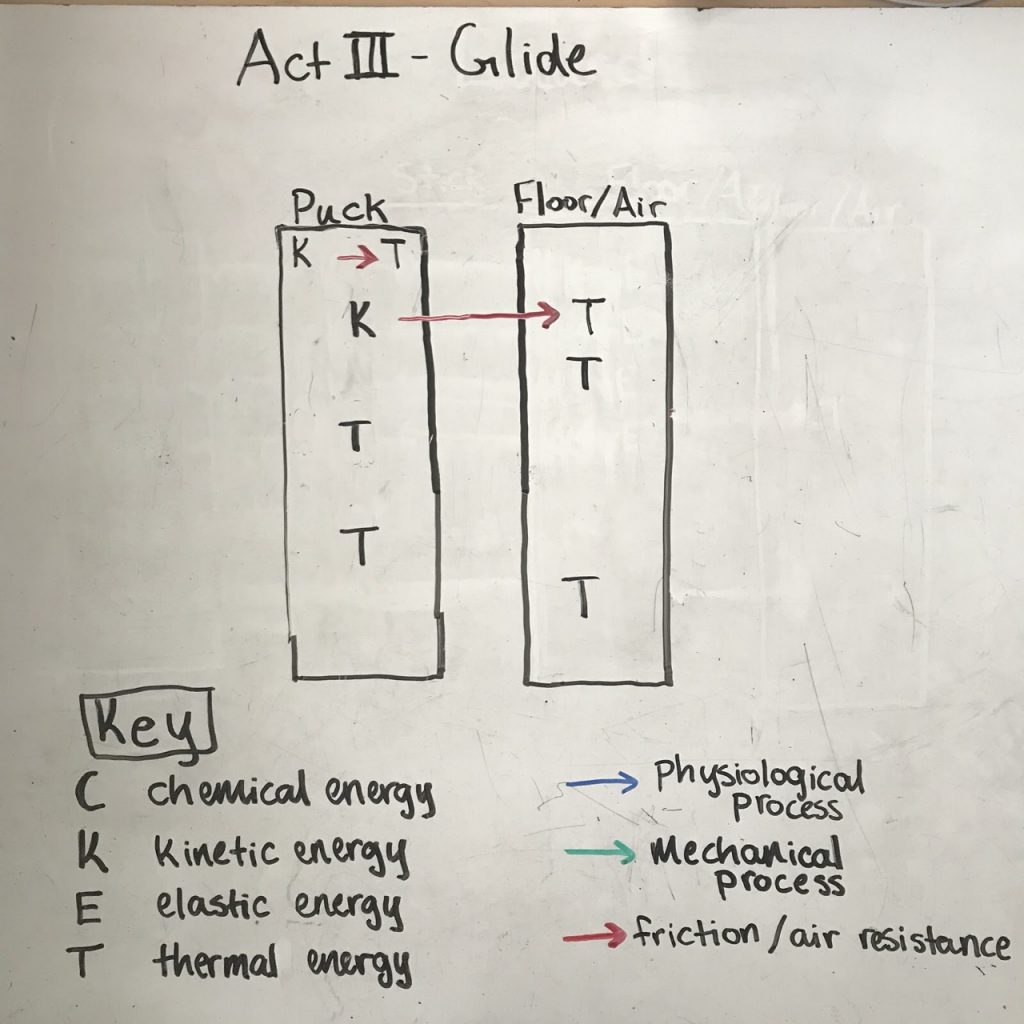
During this act kinetic energy in the puck transforms into thermal energy as a result of friction.
Energy cube representation
Sample Snapshot Energy Diagrams
Pullback Act
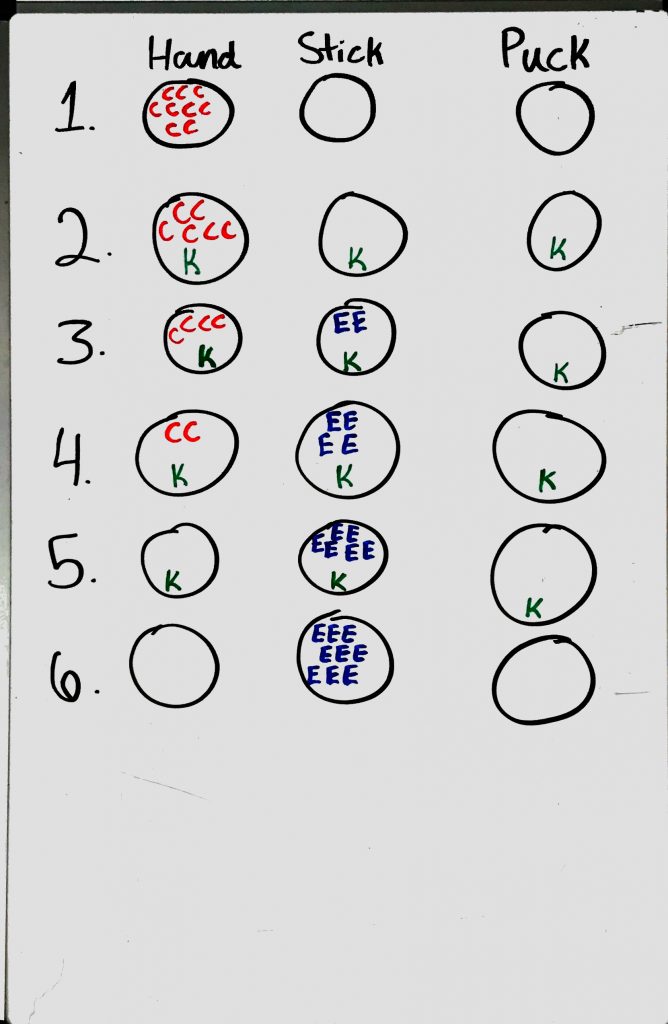
Launch Act
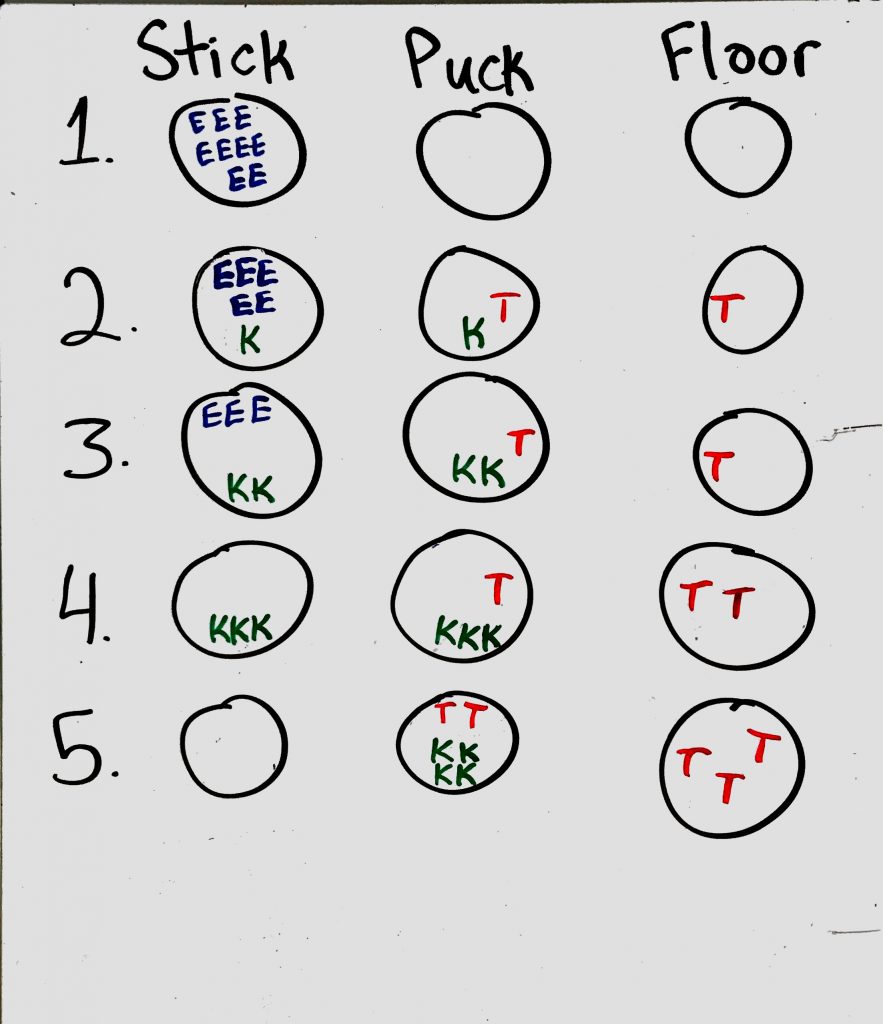
Glide Act
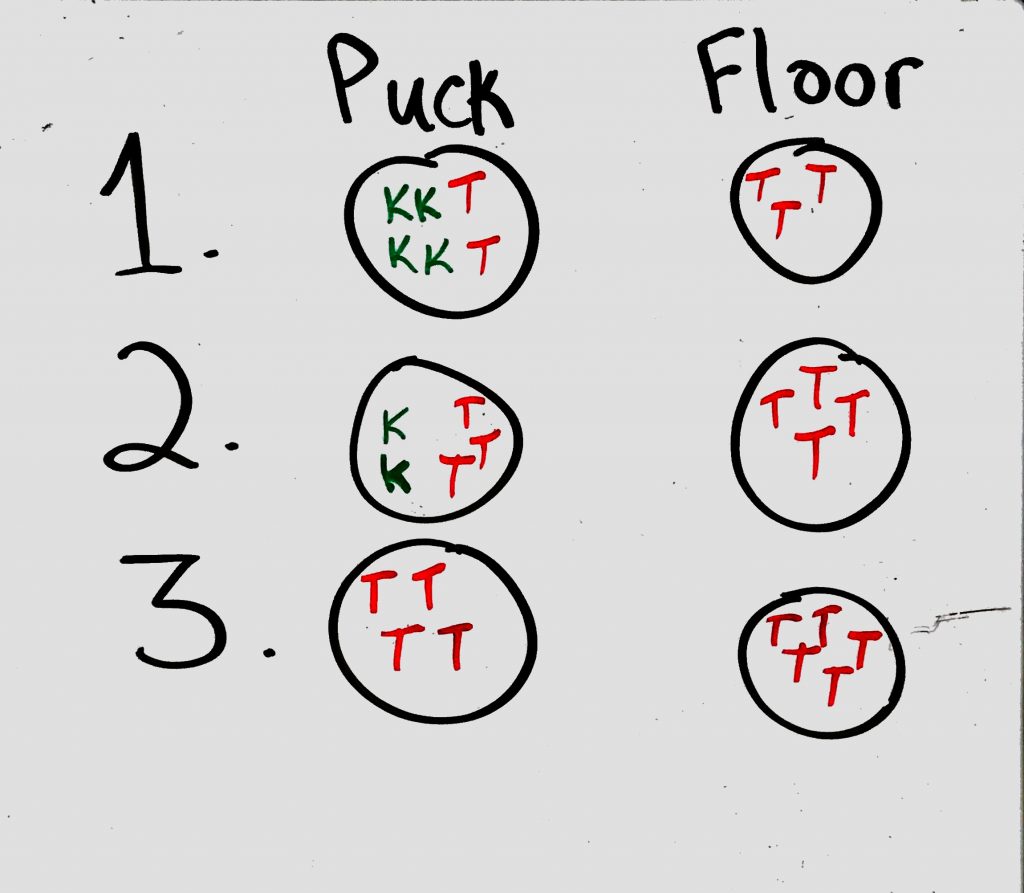
Instructor Notes
Anticipating Student Ideas/Questions
Questions that may come up when students engage with the pull back act:
- Where does the kinetic energy in the ruler and puck come from?
- This scenario can be a great opportunity to introduce a person as an object in an energy scenario. The kinetic energy in the ruler and puck will then transfer from the kinetic energy in the person which has transformed from chemical energy in the person.
- What type of energy does a person have?
- We usually call this kinetic energy but when students are given the opportunity to create their own terms they may refer to this as food energy or body energy or any other term that makes sense to them.
- Does the puck have energy if it is just moving along with the ruler and hand?
- Yes. Some students may not think of the puck (or the ruler) as having energy because it is not moving on its own. This may be an opportunity to remind students about the role of indicators in energy. Since the puck is moving with a given speed, it must have kinetic energy.
- Does the ruler have elastic energy when it is moving or does the kinetic energy transform into elastic energy only once the ruler stops moving?
- The ruler gains elastic energy as it is being pulled back. This way the amount of kinetic energy in the ruler stays constant while the amount of elastic energy steadily increases which matches the speed of the ruler that we observe.
Questions that may come up when students engage with the launch act:
- If friction causes energy to transform into thermal during the glide act does friction also cause energy to transform into thermal during the pull-back and launch acts?
- Yes. Whenever there is a friction interaction and two surfaces are sliding against each other there will be energy transformed into thermal.
- After the launch act the stick is still moving so does that mean that it did not give its energy to the puck?
- No. The stick transfers some energy to the puck but also retains some kinetic energy which transforms into elastic again as the stick bends the other way.
- It takes energy for a person to hold the puck and stick in place before the launch. Does this mean the person is transferring energy to the puck and stick?
- No. If the person’s hand is exerting a force but not moving then there would not be a mechanical transfer of energy.
- The launch act is caused by the person letting go of the stick. Does this mean that energy is transferred from the person to the stick at the beginning of the launch act?
- No. As long as the person doesn’t push the stick forward at the beginning of the launch act they would not be transferring energy to the stick. The release of the stick allows the elastic energy in the stick to transform into kinetic energy as the stick straightens.
Questions that may come up when students engage with the glide act:
- Does the motion energy go into friction?
- Friction is an interaction between the puck and the floor rather than a form the energy can have after the sliding is over.
- Does the motion energy goes into potential energy because the puck is no longer moving but has the potential to move?
- Energy would need to be transferred to the puck to allow it to move so the ability to be moved again does not indicate the presence of energy.
- Does the motion energy go into gravitational energy because gravity pulling down on the block is what causes the friction?
- No. The gravitational energy would only change if the height of the puck changed.
- Is it really possible that most of the motion energy goes into thermal energy even though you can’t even feel the puck or floor get warmer?
- Yes. Often a significant change in thermal energy results is very difficult to detect.
Each of these prevalent responses represents productive disciplinary engagement on the part of the learners. They are thinking scientifically in trying to reconcile their physical insights with the energy conservation principle. We are particularly intrigued by the final response in which learners have difficulty reconciling the increase in thermal energy with the decrease in motion energy. We hypothesize that this difficulty derives from the differences in the sensibility of these two energy forms. The motion energy is clearly visible and palpable if you imagine stopping the puck with your hand. In contrast, the thermal energy cannot be seen or felt.
Notes on Energy Acts
Students will have different ideas about when the launch act should end and the glide act begins. This provides an excellent opportunity for discussion and negotiation. For example:
- What is the shape of the stick at the moment that the puck leaves the stick?
- The puck leaves the stick after the stick is completely straight but before the stick is fully bent.
- Does the puck have the maximum speed at the moment it leaves the stick?
At the moment the glide act begins for the puck there is another energy act or acts that begins for the stick. It is OK to decide just to focus on the energy story of the puck at this point. Some students may also want to explore the energy story of the stick as it flexes back and forth.
Example of a Complex Energy Diagram
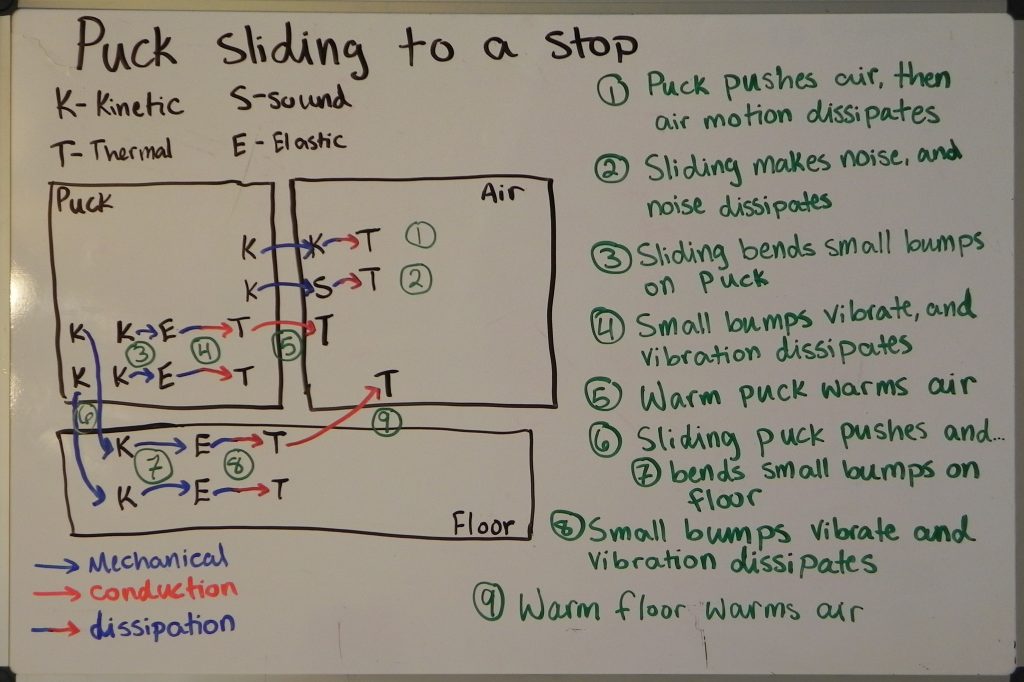
This is an example of a relatively complex diagram for this scenario. For a discussion of strategies for encouraging students to construct more complex diagrams see the page Encouraging a Complex Model.
Further Discussion
Questions you can ask to encourage more complex analysis:
- Do you think there is air resistance involved in this process? How would that show up as an energy process?
- If you could zoom in on the surface where the bottom of the puck is sliding across the floor what do you think you would see?
Possible experimental investigations:
Both the distance that the meter stick is pulled back and the distance the puck slides can be carefully measured. Students can use tape to mark positions on the floor. Therefore, this scenario provides an ideal context for careful experimental investigation. Students can be challenged to devise experiments and interpret their experimental results from an energy perspective. A few possible avenues for exploration would be:
- If we put a paper cap on the puck so that it is about twice as tall but not significantly more massive, what effect does that have on the distance that it will slide?
- If we pull the meter stick back twice as far does the puck go about twice as far, significantly less than twice as far, or significantly more than twice as far?